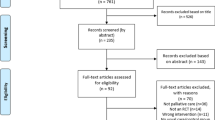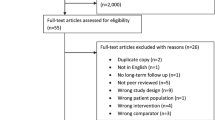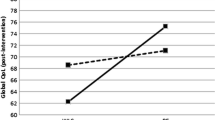Abstract
Goal
This review applied meta-analytic procedures to integrate primary research findings that tested exercise interventions among people treated for cancer.
Methods
Extensive literature searching strategies located published and unpublished intervention studies that tested exercise interventions with at least five participants (k=30). Primary study results were coded. Meta-analytic procedures were conducted.
Main results
The overall weighted mean effect size (ES) for two-group comparisons was 0.52 (higher mean for treatment than control) for physical function, 0.35 for symptoms other than fatigue, and 0.27 for body composition. More modest positive ESs were documented for mood (0.19), quality of life (0.14), fatigue (0.11), and exercise behavior (0.04). ESs were larger among single-group pre–post design studies. ESs among control group participants were typically negative and not (statistically) significantly different from 0.
Conclusions
Exercise interventions resulted in small positive effects on health and well-being outcomes among existing studies. Future research should examine intervention-specific characteristics that result in optimal results, such as dose.
Similar content being viewed by others
Refrences
Aziz NM (2002) Cancer survivorship research: challenge and opportunity. J Nutr 132(11 Suppl):3494S–3503S
Berglund G, Bolund C, Gustafsson UL, Sjoden PO (1994) One-year follow-up of the ’Starting Again’ group rehabilitation programme for cancer patients. Eur J Cancer 30A(12):1744–1751
*Burnham TR, Wilcox A (2002) Effects of exercise on physiological and psychological variables in cancer survivors. Med Sci Sports Exerc 34(12):1863–1867
Chlebowski RT, Aiello E, McTiernan A (2002) Weight loss in breast cancer patient management. J Clin Oncol 20(4):1128–1143
Conn V, Rantz M (2003) Research methods: managing primary study quality in meta-analyses. Res Nurs Health 26:322–333
Conn V, Rantz M, Maas M, Wipke-Tevis D (2001) Designing effective nursing interventions. Res Nurs Health 24(5):433–442
Conn V, Isamaralai S, Rath S, Jantarakupt P, Wadhawan R, Dash Y (2003) Beyond MEDLINE for literature searches. J Nurs Scholarsh 35:177–182
Conn V, Valentine J, Cooper H, Rantz M (2003) Grey literature in meta-analyses. Nurs Res 52:256–261
Cook DJ, Guyatt GH, Ryan G (1993) Should unpublished data be included in meta-analyses? JAMA 269:749–753
Courneya KS, Friedenreich CM (1999) Physical exercise and quality of life following cancer diagnosis: a literature review. Ann Behav Med 21(2):171–179
Courneya KS, Friedenreich CM (2001) Framework PEACE: an organizational model for examining physical exercise across the cancer experience. Ann Behav Med 23(4):263–272
*Courneya KS, Friedenreich C, Quinney HA, Fields ALA, Jones LW, Fairey AS (2003) A randomized trial of exercise and quality of life in colorectal cancer survivors. Eur J Cancer Care 12(4):347–357
*Courneya KS, Friedenreich CM, Sela RA, Quinney HA, Rhodes RE, Handman M (2003) The group psychotherapy and home-based physical exercise (group–hope) trial in cancer survivors: physical fitness and quality of life outcomes. Psychooncology 12(4):357–374
*Courneya KS, Mackey JR, Bell GJ, Jones LW, Field CJ, Fairey AS (2003) Randomized controlled trial of exercise training in postmenopausal breast cancer survivors: cardiopulmonary and quality of life outcomes. J Clin Oncol 21(9):1660–1668
*Craddock RB, Adams PF, Usui WM, Mitchell L (1999) An intervention to increase use and effectiveness of self-care measures for breast cancer chemotherapy patients. Cancer Nurs 22(4):312–319
Cunningham BA, Morris G, Cheney CL, Buergel N, Aker SN, Lenssen P (1986) Effects of resistive exercise on skeletal muscle in marrow transplant recipients receiving total parenteral nutrition. JPEN J Parenter Enteral Nutr 10(6):558–563
Decker WA, Turner-McGlade J, Fehir KM (1989) Psychosocial aspects and the physiological effects of a cardiopulmonary exercise program in patients undergoing bone marrow transplantation (BMT) for acute leukemia (AL). Transplant Proc 21(1 Pt3):3068–3069
Devine E (2003) Meta-analysis of the effect of psychoeducational interventions on pain in adults with cancer. Oncol Nurs Forum 30:75–89
*Dimeo F, Bertz H, Finke J, Fetscher S, Mertelsmann R, Keul J (1996) An aerobic exercise program for patients with haematological malignancies after bone marrow transplantation. Bone Marrow Transplant 18(6):1157–1160
*Dimeo F, Tilmann MH, Bertz H, Kanz L, Mertelsmann R, Keul J (1997) Aerobic exercise in the rehabilitation of cancer patients after high dose chemotherapy and autologous peripheral stem cell transplantation. Cancer 79(9):1717–1722
*Dimeo F, Fetscher S, Lange W, Mertelsmann R, Keul J (1997) Effects of aerobic exercise on the physical performance and incidence of treatment-related complications after high-dose chemotherapy. Blood 90(9):3390–3390
*Dimeo F, Rumberger BG, Keul J (1998) Aerobic exercise as therapy for cancer fatigue. Med Sci Sports Exerc 30(4):475–478
*Dimeo FC, Stieglitz RD, Novelli-Fischer U, Fetscher S, Keul J (1999) Effects of physical activity on the fatigue and psychologic status of cancer patients during chemotherapy. Cancer 85(10):2273–2277
*Durak EP, Lilly PC (1998) The application of an exercise and wellness program for cancer patients: a preliminary outcomes report. J Strength Cond Res 12(1):3–6
*Durak E, Lilly PC (1999) Preliminary results of exercise in breast cancer: a two-year follow-up survey. J Rehabil Outcomes Meas 3(4):53–60
*Durak EP, Lilly PC, Hackworth JL (1999) Physical and psychosocial responses to exercise in cancer patients: a two year follow-up survey with prostrate, leukemia, and general carcinoma. J Exerc Physiol Online 2(1)
Fairey AS, Courneya KS, Field CJ, Mackey JR (2002) Physical exercise and immune system function in cancer survivors: a comprehensive review and future directions. Cancer 94(2):539–551
Friedenreich CM, Courneya KS (1996) Exercise as rehabilitation for cancer patients. Clin J Sport Med 6(4):237–244
Galvao D, Newton R (2005) Review of exercise intervention studies in cancer patients. J Clin Oncol 23(4):899–909
Gleser LJ, Olkin I (1994) Stochastically dependent effect sizes. In: Cooper H, Hedges L (eds) The handbook of research synthesis. Russell Sage Foundation, New York, pp 339–355
*Goodwin P, Esplen MJ, Butler K, Winocur J, Pritchard K, Brazel S, Gao A, Miller J (1998) Multidisciplinary weight management in locoregional breast cancer: results of a phase II study. Breast Cancer Res Treat 48(1):53–64
*Hayes S, Davies PS, Parker T, Bashford J (2003) Total energy expenditure and body composition changes following peripheral blood stem cell transplantation and participation in an exercise programme. Bone Marrow Transplant 31(5):331–338
Hedges L (1994) Fixed effects models. In: Cooper H, Hedges L (eds) The handbook of research synthesis. Russell Sage Foundation, New York, pp 285–299
Hedges L, Olkin I (1985) Statistical methods for meta-analysis. Academic, Orlando
Hedges L, Vevea J (1998) Fixed- and random-effects models in meta-analysis. Psychol Methods 3:486–504
*Holley S, Borger D (2001) Energy for living with cancer: preliminary findings of a cancer rehabilitation group intervention study. Oncol Nurs Forum 28(9):1393–1396
Holtzman J, Schmitz K, Babes G, Kane R, Duval S, Wilt T, MacDonald R, Rutks I (2004) Effectiveness of behavioral interventions to modify physical activity behaviors in general populations and cancer patients and survivors (evidence report/technology assessment no. 102 no. AHRQ publication no. 04-E027-02). Agency for Healthcare Research and Quality, Rockville
Irwin ML, Ainsworth BE (2004) Physical activity interventions following cancer diagnosis: methodologic challenges to delivery and assessment. Cancer Invest 22:30–50
Kalaian HA, Raudenbush SW (1996) A multivariate mixed linear model for meta-analysis. Psychol Methods 1:227–235
Kolden GG, Strauman TJ, Ward A, Kuta J, Woods TE, Schneider KL, Heerey E, Sanborn L, Burt C, Millbrandt L, Kalin NH, Stewart JA, Mullen B (2002) A pilot study of group exercise training (GET) for women with primary breast cancer: feasibility and health benefits. Psychooncology 11(5):447–456
Kuhn K, Boesen E, Ross L, Johansen C (2005) Evaluation and outcome of behavioural changes in the rehabilitation of cancer patients: a review. Eur J Cancer 41(2):216–224
Lubbe AS, Krischke NR, Dimeo F, Forkel S, Petermann F (2001) Health-related quality of life and pulmonary function in lung cancer patients undergoing medical rehabilitation treatment. Wien Med Wochenschr 151(1–2):29–34
Luebbert K, Dahme B, Hasenbring M (2001) The effectiveness of relaxation training in reducing treatment-related symptoms and improving emotional adjustment in acute non-surgical cancer treatment: a meta-analytical review. Psychooncology 10(6):490–502
MacVicar MG, Winningham ML, Nickel JL (1989) Effects of aerobic interval training on cancer patients’ functional capacity. Nurs Res 38(6):348–351
McKenzie DC, Kalda AL (2003) Effect of upper extremity exercise on secondary lymphedema in breast cancer patients: a pilot study. J Clin Oncol 21(3):463–466
Mock V (2004) Evidence-based treatment for cancer-related fatigue. J Natl Cancer Inst Monogr 32:112–118
*Mock V, Burke MB, Sheehan P, Creaton EM, Winningham ML, McKenney-Tedder S, Schwager LP, Liebman M (1994) A nursing rehabilitation program for women with breast cancer receiving adjuvant chemotherapy. Oncol Nurs Forum 21(5):899–907
Morris SB (2000) Distribution of the standardized mean change effect size for meta-analysis on repeated measures. Br J Math Stat Psychol 53:17–29
Morris SB, DeShon RP (2002) Combining effect size estimates in meta-analysis with repeated measures and independent-groups designs. Psychol Methods 2:105–125
*Nieman DC, Cook VD, Henson DA, Suttles J, Rejeski WJ, Ribisl PM, Fagoaga OR, Nehlsen-Cannarella SL (1995) Moderate exercise training and natural killer cell cytotoxic activity in breast cancer patients. Int J Sports Med 16(5):334–337
Nony P, Cucherat M, Haugh M, Boissell J (1995) Critical reading of the meta-analysis of clinical trials. Therapie 50:339–351
Oldervoll LM, Kaasa S, Hjermstad MJ, Lund JA, Loge JH (2004) Physical exercise results in the improved subjective well-being of a few or is effective rehabilitation for all cancer patients? Eur J Cancer 40:951–962
*Peters C, Lotzerich H, Niemeier B, Schule K, Uhlenbruck G (1994) Influence of a moderate exercise training on natural killer cytotoxicity and personality traits in cancer patients. Anticancer Res 14(3A):1033–1036
*Pinto BM, Clark MM, Maruyama NC, Feder SI (2003) Psychological and fitness changes associated with exercise participation among women with breast cancer. Psychooncology 12(2):118–126
Porock D, Kristjanson L, Tinnelly K, Duke T, Blight J (2000) An exercise intervention for advanced cancer patients experiencing fatigue: a pilot study. J Palliat Care 16(3):30–36
Raudenbush SW (1994) Random effects models. In: Cooper H, Hedges L (eds) The handbook of research synthesis. Russell Sage Foundation, New York, pp 301–321
Rock CL, Demark-Wahnefried W (2002) Can lifestyle modification increase survival in women diagnosed with breast cancer? J Nutr 132:3504S–3507S
Schwartz AL, Thompson JA, Masood N (2002) Interferon-induced fatigue in patients with melanoma: a pilot study of exercise and methylphenidate. Oncol Nurs Forum 29(7):E85–E90
*Segal R, Evans W, Johnson D, Smith J, Colletta S, Gayton J, Woodard S, Wells G, Reid R (2001) Structured exercise improves physical functioning in women with stages I and II breast cancer: results of a randomized controlled trial. J Clin Oncol 19(3):657–665
*Segal RJ, Reid RD, Courneya KS, Malone SC, Parliament MB, Scott CG, Venner PM, Quinney HA, Jones LW, D’Angelo ME, Wells GA (2003) Resistance exercise in men receiving androgen deprivation therapy for prostate cancer. J Clin Oncol 21(9):1653–1659
Segar ML, Katch VL, Roth RS, Garcia AW, Portner TI, Glickman SG, Haslanger S, Wilkins EG (1998) The effect of aerobic exercise on self-esteem and depressive and anxiety symptoms among breast cancer survivors. Oncol Nurs Forum 25(1):107–113
Servaes P, Verhagen C, Bleijenberg G (2002) Fatigue in cancer patients during and after treatment: prevalence, correlates and interventions. Eur J Cancer 38(1):27–43
Shadish W, Haddock C (1994) Combining estimates of effect size. In: Cooper H, Hedges L (eds) The handbook of research synthesis. Russell Sage Foundation, New York, pp 261–282
Stone P (2002) The measurement, causes and effective management of cancer-related fatigue. Int J Palliat Nurs 8(3):120–128
Stricker CT, Drake D, Hoyer KA, Mock V (2004) Evidence-based practice for fatigue management in adults with cancer: exercise as an intervention. Oncol Nurs Forum 31:963–974
Vevea JL, Hedges LV (1995) A general linear model for estimating effect size in the presence of publication bias. Psychometrika 60:419–435
Watson T, Mock V (2004) Exercise as an intervention for cancer-related fatigue. Phys Ther 84:736–743
Winningham ML, MacVicar MG (1988) The effect of aerobic exercise on patient reports of nausea. Oncol Nurs Forum 15(4):447–450
Zinna EM, Yarasheski KE (2003) Exercise treatment to counteract protein wasting of chronic diseases. Curr Opin Clin Nutr Metab Care 6(1):87–93
Acknowledgements
Financial support provided by a grant from the NIH NINR (RO1NR07870) to Vicki Conn, principal investigator.
Author information
Authors and Affiliations
Corresponding author
Additional information
An erratum to this article is available at http://dx.doi.org/10.1007/s00520-007-0326-8.
Footnote
Footnote
Unpublished studies in the meta-analyses included the following:
Christopher KA, Morrow L (2003) Evaluating a community-based exercise program for women cancer survivors. Unpublished Data
Djuric Z, DiLaura NM, Bradley E, Hryniuk W (2003) Weight loss intervention in African American breast cancer survivors. Presented at American Society of Preventive Oncology
Durak E, Lilly PC (2003) Effects of an out-patient exercise and wellness program on cancer patients: 1st year outcomes. Paper presented at the American College of Sports Medicine
Hall JL (1998) Psychological interventions for exercise and dietary behavior change with breast cancer survivors. Dissertation, Temple University, US
Hansen G (1997) Quality of life, physical activity, and rehabilitation of women treated for breast cancer. Unpublished masters thesis, Norweigian University of Sport and Physical Education
Kollman MA, Burnham TR, Sims C, Tuttle J (2003) Low to moderate intensity aerobic exercise improves quality of life in cancer survivors. Unpublished data
Kramer MM (1996) The effects of exercise on psychological well-being in women recovering from breast cancer. Dissertation, Arizona State University, US
Pfalzer LA (1989) The responses of bone marrow transplant patients to graded exercise testing prior to transplant and after transplant with and without exercise training. Unpublished dissertation, Ohio State University
Rights and permissions
About this article
Cite this article
Conn, V.S., Hafdahl, A.R., Porock, D.C. et al. A meta-analysis of exercise interventions among people treated for cancer. Support Care Cancer 14, 699–712 (2006). https://doi.org/10.1007/s00520-005-0905-5
Received:
Accepted:
Published:
Issue Date:
DOI: https://doi.org/10.1007/s00520-005-0905-5




